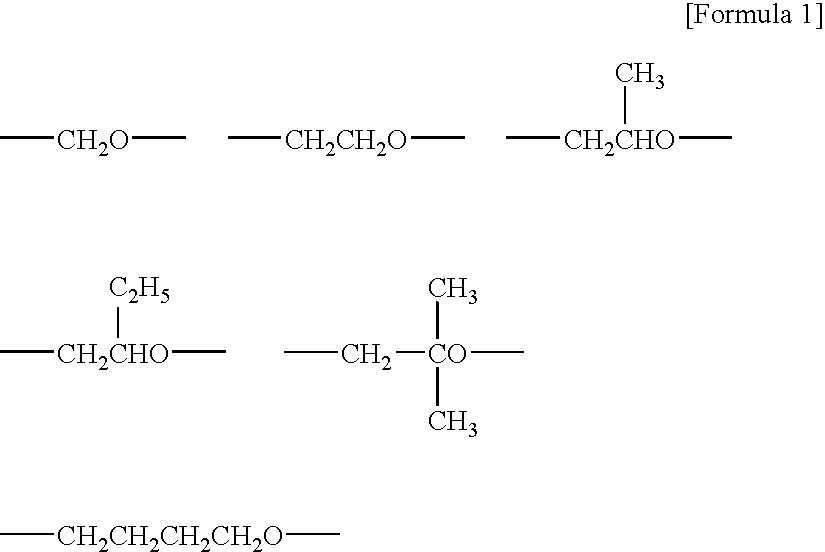Curable Composition
- Summary
- Abstract
- Description
- Claims
- Application Information
AI Technical Summary
Benefits of technology
Problems solved by technology
Method used
Image
Examples
synthesis example 1
[0200] Polyoxypropylene diol having a molecular weight of about 2,000 was used as an initiator to polymerize propylene oxide in the presence of a zinc hexacyanocobalate glyme catalyst to yield a polypropylene oxide having at its terminals hydroxyl groups and having a number-average molecular weight of about 25,500, which was a molecular weight in terms of polystyrene measured by use of an HLC-8120 GPC manufactured by Tosoh Corp. as a liquid-feeding system, a TSK-GEL H type column manufactured by Tosoh Corp., and THF as a solvent. Subsequently, a solution of NaOMe in methanol was added thereto at an equivalent 1.2 times the amount of the hydroxyl groups of this hydroxyl-group-terminated polypropylene oxide, and methanol was distilled off. Furthermore, allyl chloride was added thereto so as to convert the hydroxyl groups at the terminals to allyl groups. Unreacted allyl chloride was volatilized and removed under reduced pressure. Into 100 parts by weight of the resultant crude allyl-g...
synthesis example 2
[0202] Instead of the silane compound in Synthesis Example 1, 0.9 parts by weight of methyldimethoxysilane was used, and the same operation as in Synthesis Example 1 was performed to yield a methyldimethoxysilyl-group-terminated polyoxypropylene based polymer (A-2). The average number of the methyldimethoxysilyl groups at the terminals was 1.3 per molecule according to measurement by 1H-NMR (measurement made in CDCl3 solvent by use of a JNM-LA400 manufactured by JEOL Ltd.).
examples 5 to 8
, and Comparative Examples 2 to 5
[0205] An organic polymer (A-1 or A-2) having a reactive-silicon-containing group and fillers were mixed and kneaded at each ratio shown in Table 2 by use of a three-axis roll. The resultant was used as a main agent.
[0206] Under the condition of a constant temperature of 23° C. and a constant humidity of 50%, one out of various amine compounds (B1) shown in Table 2 was added to the main agent, and then a spatula was used to mix and knead these components for 2 minutes. Thereafter, the blend was sufficiently degassed. The surface of the blend was made flat to set thickness of the blend to 3 mm or more. This time was defined as the curing start time, and the curing time was measured. At intervals of 1 minute, a tip of the spatula was brought into contact with the mixture surface. The time until the mixture came not to adhere onto the spatula was defined as the skin formation time. The results are shown in Table 2.
TABLE 2ExamplesComparative ExamplesC...
PUM
| Property | Measurement | Unit |
|---|---|---|
| Fraction | aaaaa | aaaaa |
| Fraction | aaaaa | aaaaa |
| Percent by mass | aaaaa | aaaaa |
Abstract
Description
Claims
Application Information
 Login to View More
Login to View More - R&D
- Intellectual Property
- Life Sciences
- Materials
- Tech Scout
- Unparalleled Data Quality
- Higher Quality Content
- 60% Fewer Hallucinations
Browse by: Latest US Patents, China's latest patents, Technical Efficacy Thesaurus, Application Domain, Technology Topic, Popular Technical Reports.
© 2025 PatSnap. All rights reserved.Legal|Privacy policy|Modern Slavery Act Transparency Statement|Sitemap|About US| Contact US: help@patsnap.com


